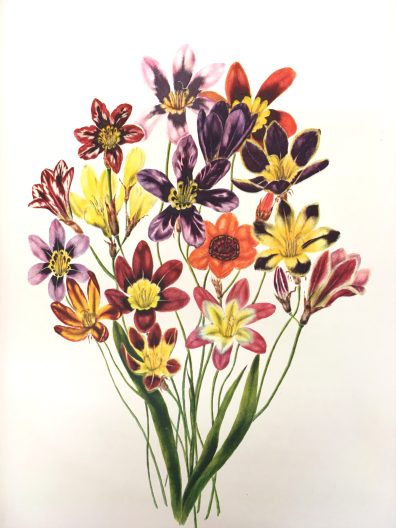 Librarians are often called upon to solve mysteries, and we enjoying hearing the stories of triumphs by our colleagues. One of my favorites is the story of Mary Gunn (1899-1989), a librarian at the Botanical Research Institute in Pretoria, South Africa. She had a special interest in the history of botany and botanical illustration.
Librarians are often called upon to solve mysteries, and we enjoying hearing the stories of triumphs by our colleagues. One of my favorites is the story of Mary Gunn (1899-1989), a librarian at the Botanical Research Institute in Pretoria, South Africa. She had a special interest in the history of botany and botanical illustration.
In the 1930s, she began researching a book in her library’s collection titled “Specimens of the Flora of South Africa by a Lady” and published in England in 1849. This book included nine plates of colorful, native plants noteworthy for their quality. The identity of the “Lady” was unknown.
Gunn used her research skills over a period of nearly 20 years to discover the artist was Arabella Elizabeth Roupell (1817-1914), the wife of a British judge who was in Cape Town, South Africa for only two years in the early 1840s. Having much leisure time, Roupell would ride on horseback to collect plants for painting, often accompanied by a British botanist who later introduced her to William Hooker, the first director of Kew and father of Joseph.
Hooker was very impressed with Roupell’s work that included about 100 paintings. He promoted the publication of a sele ct few in “Specimens,” but why this was done anonymously is unknown. The book received high praise at the time, with a copy being given to Queen Victoria. There were only 110 printed, and those soon became rare collector’s items.
ct few in “Specimens,” but why this was done anonymously is unknown. The book received high praise at the time, with a copy being given to Queen Victoria. There were only 110 printed, and those soon became rare collector’s items.
Through Gunn’s exhaustive efforts, she not only discovered this history, but also the location of the original paintings. With the help of the South African government, they were returned to the University of Cape Town in the 1950s. “More Cape Flowers by a Lady” was published in 1964 with reproductions of eleven of the original pieces and a text by Allan Bird that included their history. While the Miller Library does not have the earlier book, we are pleased to have this limited, later publication.
Reviewed by: Brian Thompson on November 21, 2023
Excerpted from the Winter 2024 issue of the Arboretum Bulletin